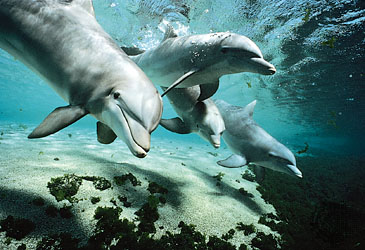|
Patna, Oct
8 :Bodies of at least half a dozen endangered Ganges river dolphins have been
found near a railway track at Hathidah in Bihar's Patna district. The dolphins
had been cut into pieces and stuffed into eight sacks. The
incident is seen here as a major setback to the ongoing conservation of the endangered
Ganges river dolphin. "Bodies
of dolphins were found cut into pieces in eight sacks Sunday morning. But we are
yet to find out how many dolphins were killed and packed," a police source
said. The
wildlife department said bodies of at least six dolphins cut into pieces in eight
sacks were found near a railway track at Hathidah on Mokama-Begusarai route, about
100 km from Patna. A
local source in Mokama told IANS over telephone that at least 7-8 dolphins were
killed and cut into pieces. The
sacks were noticed by the villagers near a railway track and the police were informed.
"The
evidence suggests that the consignment was being taken to Kolkata or northeastern
states by train. And something must have forced the smugglers to throw them out
of the train," a police official said. Dolphins
are locally called sons of the Ganges river, but pollution and rampant fishing
have threatened their existence. In
last two years, nearly a dozen dolphins were found dead in the state. They were
killed after they were trapped in fishing nets. Dolphin experts said the endangered
animals are also killed for their meat, skin and oil. The
experts said the actual death toll never gets recorded since only a few incidents
get reported. The carcasses are either buried or thrown into the river. 
The
government had set up the Vikramshila Gangetic Dolphin Sanctuary in Bhagalpur
district a decade ago for conservation of the species. The sanctuary is spread
over a 50-km stretch of the Ganges. Last
year, Bihar Chief Minister Nitish Kumar had announced a plan to save the species,
but things have hardly moved beyond that. "Nothing
has happened at the ground level to save them," an official admitted on condition
of anonymity. R.K.
Sinha, head of the zoology department at Patna University, said: "If we fail
to save these mammals, the future generations may only see them in photographs. "A
rapidly shrinking Ganges and the river's changing course are threatening the dolphins,"
said Sinha, who also heads the central government's dolphin conservation project. Sunil
Choudhary, another wildlife expert, said: "On paper conservation work is
going on. But in reality the sanctuary has no formal conservation plan. Unless
locals are involved in conservation and awareness is created, dolphins will continue
to die." Untreated
sewage, rotting carcasses and industrial effluents that find their way into the
Ganges during its 2,500-km-long journey across several states from the Himalayas
to the Bay of Bengal adversely affected the dolphins, he said. The
Ganges has already shifted its course near Patna. It now flows two kilometres
away from the city, thanks to silting and pollution. Researchers
estimate the dolphin population across India to be a little over 1,500. Half of
these are found in the Ganges in Bihar. The numbers have dropped drastically over
the past decades. In the 1980s, the Gangetic delta zone alone had around 3,500
dolphins. In
1996, freshwater dolphins were categorised as an endangered species by the World
Conservation Union (IUCN), a forum of conservationists, NGOs and government agencies. (IANS) Comment Comments... People
should be educated through media regarding importance of protection of endangered
species. S.K.Roy
Chaudhary skrc88@gmail.com
|